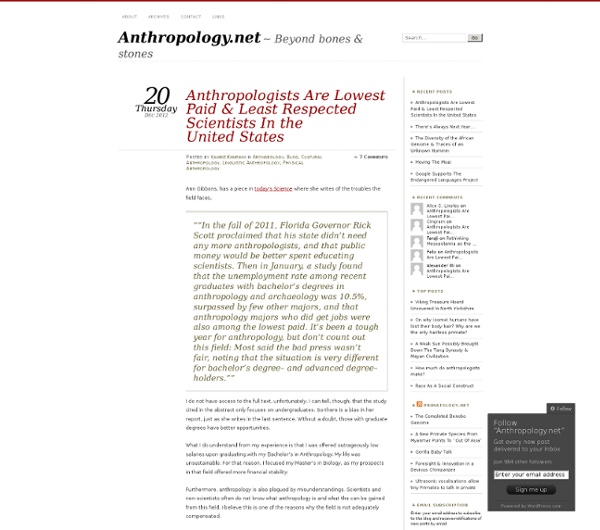



The Monkey Wars Anthropiques.org Open Access Anthropology | Just another WordPress site Anthropology & Law Psychasoc - institut européen psychanalyse et travail social The impact of the web 2.0 world on the Records Management Society | Thinking Records Great quote from Andy Powell, in this blogpost. The quote is about CILIP (Chartered Institute of Library and Information Professionals) but could equally well be referring to any membership society Asking “how should CILIP use Web 2.0 to engage with its members?” The business model of the large UK membership societies is that in return for a membership fee they will provide exclusive access to news, information resources and networking opportunities. It is a triple whammy. The time was when the only way that you could keep up with news and opinions from a profession was through the relevent membership society’s newsletter/bulletin/journal. The web 2.0 world provides opportunities as well as threats to membership societies. The publications of membership societies Most membership Society regard the publications that they produce as member only benefits, to be distributed to members in hard copy and made available (to members only) online. The impact of web 2.0 on events and conferences
Great ape language Research into great ape language has involved teaching chimpanzees, bonobos, gorillas, and orangutans to communicate with human beings and with each other using sign language, physical tokens, and lexigrams; see Yerkish. Some primatologists argue that the primates' use of these tools indicates their ability to use "language", although this is not consistent with some definitions of that term. Questions in animal language research[edit] Animal language research attempts to answer the following questions: What problems can animals solve without language, and can they solve them better after they have received language training?Can the lessons learned in teaching animals be applied to human children? Apes that demonstrate understanding[edit] Primate use of sign language[edit] Many researchers into animal language have presented the results of the studies described below as evidence of linguistic abilities in animals. Washoe[edit] The Gardners used many different training methods: Kanzi[edit]
Powerful Portraits of Individuals Before and Directly After Their Death Name: Jan Andersen. Age: 27 Born: 21st of February 1978 Died: 14th June 2005, at Leuchtfeuer Hospice, Hamburg Jan Andersen was 19 when he discovered that he was HIV-positive. On his 27th birthday he was told that he didn’t have much time left: cancer, a rare form, triggered by the HIV-infection. He did not complain. He put up a short, fierce fight – then he seemed to accept his destiny. “You’re still here?” In the final stages, the slightest physical contact had caused him pain. Name: Elmira Sang Bastian Age: 17 months Born: 18th October 2002 Died: 23rd March 2004, at her parent’s home The tumor was probably already present when Elmira was born. One sunny day, Elmira stops breathing. Photographer Walter Schels was terrified of death, so much so he refused to see his mother after she passed away. Schels and his partner Beat Lakotta began approaching potential individuals at hospices in Berlin and Hamburg, surprised to find few people said no. Michael Lauermann was a manager.
Early Bronze Age battle site found on German river bank 22 May 2011Last updated at 07:38 By Neil Bowdler Science reporter, BBC News One of the finds from the site included this human skull with a large fracture Fractured human remains found on a German river bank could provide the first compelling evidence of a major Bronze Age battle. Archaeological excavations of the Tollense Valley in northern Germany unearthed fractured skulls, wooden clubs and horse remains dating from around 1200 BC. The injuries to the skulls suggest face-to-face combat in a battle perhaps fought between warring tribes, say the researchers. The paper, published in the journal Antiquity, is based primarily on an investigation begun in 2008 of the Tollense Valley site, which involved both ground excavations and surveys of the riverbed by divers. They found remains of around 100 human bodies, of which eight had lesions to their bones. The injuries included skull damage caused by massive blows or arrowheads, and some of the injuries appear to have been fatal.
Fermented beverages of pre- and proto-historic China Proceedings of the National Academy of Sciences of the United States of Americawww.pnas.org Author Affiliations Communicated by Ofer Bar-Yosef, Harvard University, Cambridge, MA, November 16, 2004 (received for review September 30, 2003) Abstract Chemical analyses of ancient organics absorbed into pottery jars from the early Neolithic village of Jiahu in Henan province in China have revealed that a mixed fermented beverage of rice, honey, and fruit (hawthorn fruit and/or grape) was being produced as early as the seventh millennium before Christ (B.C.). Footnotes ↵ † To whom correspondence should be addressed.
THE THINKING OF THOUGHTS Gilbert RyleReprinted from 'University Lectures', no.18, 1968, by permission of the University of Saskatchewan I begin by drawing your attention to a special, but at first sight merely curious feature of the notion of doing something, or rather of trying to do something. In the end I hope to satisfy you that this feature is more than merely curious; it is of radical importance for our central question, namely, What is le Penseur doing? Two boys fairly swiftly contract the eyelids of their right eyes. In the first boy this is only an involuntary twitch; but the other is winking conspiratorially to an accomplice. So far we are on familiar ground. Similarly, sloping arms in obedience to an order differs, but does not differ in number of actions from just sloping arms. Come back to our winker. Part of this can be brought out in another way. It is now time to begin to apply these short ideas. You hear someone come out with 'Today is the 3rd of February'. (d) Practising is rather similar.